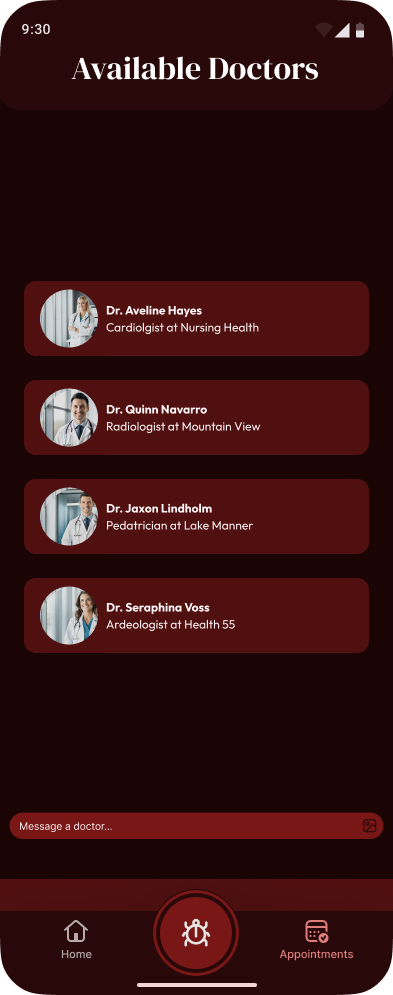Bridging the Care Gap: Empowering Patients and Doctors to Stay Connected
Med-Health
Optimizes healthcare operations by providing AI-driven tools for scheduling, records management, and patient engagement. Its solutions reduce administrative burdens, improve efficiency, and enhance care coordination—helping providers focus on patients while cutting costs
38
%
Of patients only can easily access their medical records (ONC, 2022)
30
%
Of lab tests are repeated due to missing records, costing $8 billion annually (Journal of the American Medical Association).
88
M+
Individuals were affected by healthcare data breaches in 2023 (HIPAA Journal).
Patients & Medical Practitioners
Imagine you are a young adult who’s just been diagnosed with a condition that needs regular monitoring. You’re juggling test results, appointment notes, and questions that pop up at 2 AM — but your health information feels scattered and impossible to manage.
Now, imagine an app that uses AI and thoughtful UX design to gather all your medical data in one secure place. It understands your test results, explains them in plain language, and even suggests questions to ask your doctor. When it’s time for an appointment, you can share your info instantly, so your doctor sees the full picture. Suddenly, you feel less alone and more in control. Managing your health becomes clearer, your care team stays connected, and you get to focus on feeling better — not buried in paperwork.
We believe medical data should empower patients — not overwhelm them.
To achieve this, we:
- Design with empathy using Figma to build interfaces that feel approachable, especially for patients managing complex health needs. Every screen is built with clarity and ease-of-use in mind.
- Ideate with purpose in Bolt to transform static designs into rich, interactive systems — allowing for fluid data collection, real-time updates, and seamless doctor-patient communication.
- Validate through user insight by using Google Forms to conduct usability testing and uncover pain points directly from real users. Their feedback directly informs our design decisions and product evolution.
- Prioritize transparency and usability through heuristic evaluations and iterative refinements, ensuring each interaction builds confidence in the product’s reliability and clarity.

How I used Figma, Bolt, and Google Forms to design Med-Health, leading to a more interactive system and user-validated experience.
I used Figma to design clear, user-centered interfaces that help patients easily collect and manage their medical data. With Bolt, I turned those designs into a more in-depth, interactive system — making sure the workflows felt intuitive and the features worked seamlessly together.
To ensure everything met real user needs, I used Google Forms to conduct usability testing, gathering direct feedback to refine pain points and improve the overall experience.
The result? A thoughtfully designed Med-Health platform that empowers patients to stay informed and connected with their doctors — all built through strong design, hands-on development, and meaningful user testing.
Med-Health: Designing User Flows Within Regulatory Boundaries
In my work with Med-Health, I encountered the challenge of designing clear, intuitive user flows while balancing strict industry regulations and organizational red tape. Understanding these complex guidelines was essential to ensure that every touchpoint met compliance standards without compromising usability.
To overcome this, I conducted in-depth research to map out relevant policies and constraints, then translated those requirements into user-friendly pathways. By collaborating closely with stakeholders and validating flows against compliance needs, I was able to deliver designs that prioritized patient and provider needs — all while staying firmly within regulatory boundaries.
This experience strengthened my ability to merge thoughtful UX design with real-world constraints, ensuring that the final product was both effective and compliant.
80
Percent Satisfaction Score in Navigation
80
Percent of users found Med-Bot (AI) to be helpful, driving efficiency and ease-of-use
50
Percent reduction in time to book appointments
Operational Efficiency
- Projected 25% faster appointment bookings, reducing administrative burden on staff.
- Projected 40% decrease in support calls related to navigation or test results.
Competitive Differentiation
- Unique Selling Point (USP): Med-Health became known for "stress-free medical data"—a key differentiator in a crowded market.
Compliance & Risk Mitigation
- Reduced legal exposure by ensuring HIPAA/GDPR compliance in UX (e.g., secure messaging defaults).
- Built trust with providers through transparent data sharing features.
Scalability
- Partnership Opportunities: As a future feature, Clinics have the opportunity to scale their efforts by connecting their API directly to be more in-tune with their systems
How I used persona development, user flows, and usability testing to create Med-Health — giving patients a clear, confident way to manage their care
I began by developing clear personas to understand what different patients needed from a medical app. From there, I mapped out detailed user flows in Figma, focusing on how patients would add and organize medical records, upload results, and message their doctors seamlessly
To make sure these flows felt intuitive, I used Google Forms to run targeted usability tests. I asked real users to complete tasks step-by-step, gathered insights on where they struggled, and iteratively refined each flow to remove friction and confusion

















